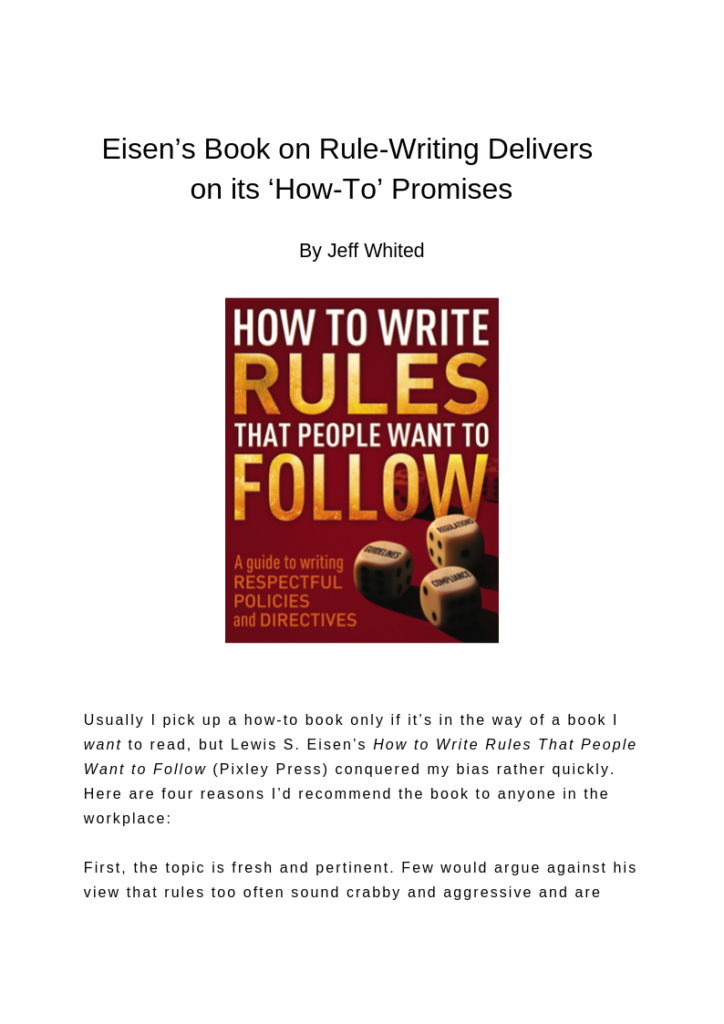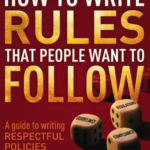Eisen’s Book on Rule-Writing Delivers on its ‘How-To’ Promises

Usually I pick up a how-to book only if it’s in the way of a book I want to read, but Lewis S. Eisen’s How to Write Rules That People Want to Follow (Pixley Press) conquered my bias rather quickly. Here are four reasons I’d recommend the book to anyone in the workplace:
First, the topic is fresh and pertinent. Few would argue against his view that rules too often sound crabby and aggressive and are frequently unclear. In the opening pages, he writes “Well-written policies don’t sound like angry parents talking to naughty children. Well-written policies sound like adults talking respectfully to adults.” And, he continues, this aggressive tone is ironic “because most organizations genuinely care about respect in the workplace.” The problems with rules, policies, and directives, he writes in Chapter 1, are lack of clarity, lack of focus, and lack of respect. Accordingly, throughout the book, Eisen provides examples that are clear, focused, and respectful.
Second, the book delivers on the promise of its title. Too many instructional products contain exhaustive descriptions of the problems – essentially reminding the audience of what is wrong in the first place, almost to the point of “rubbing it in.” But what audiences really want are solutions. Here, Eisen provides specific answers all the way through. Of particular value are his distinctions between policies and guidance: “The failure to distinguish policy statements from guidance statements is the critical flaw in the policy instruments of most organizations.” When the crafters of rules and policies grasp this distinction, their guidance documents – which are what most of us actually see – should improve notably.
Third, it passes the “YouTube 50-Percent Test.” If you’ve ever clicked YouTube videos that promise to solve your household problems, you know it’s safe to skip the first half because that’s how long it takes the presenters to introduce themselves and any house pets that stray into view, and then to blithely describe the frustrations of having a leaky toilet or a spasmodic garage door, indifferent to the fact that your hardware store closes in twenty minutes. Eisen’s book has no maddening “fast-forward” sections, except perhaps for its very brief summaries of what each chapter will entail – and, again, these are very brief.
Fourth, the book is easy to read. The words on the page don’t try too hard; you know you’re in pretty good hands. This excerpt from the Introduction, for instance, typifies the conversational feel even as it gives you a glimpse of what’s ahead: “This book will not tell you what your rules should be; you need to decide that yourself. This book is about how to convey that decision once it’s made. We’re not going to be distracted by how to vote or reach consensus, who to consult, or how to manage the rule-making process.”
How to Write Rules That People Want to Follow can be purchased from most major retailers. See also Eisen’s August 2019 ARMA magazine article, “Can Information Management Policies Be Both Clear and Concise?”

View the PDF version of this article.
About the Author
 Communications2019.09.17Eisen’s Book on Rule-Writing Delivers on its ‘How-To’ Promises
Communications2019.09.17Eisen’s Book on Rule-Writing Delivers on its ‘How-To’ Promises Analytics2019.09.06Will Google Play Fair in the ‘Privacy Sandbox?’
Analytics2019.09.06Will Google Play Fair in the ‘Privacy Sandbox?’ Electronic Records Management2019.06.18Goals of New Canadian Digital Charter Include Assuring Privacy, Eradicating Hate Online
Electronic Records Management2019.06.18Goals of New Canadian Digital Charter Include Assuring Privacy, Eradicating Hate Online Analytics2019.06.11Why Are Businesses Opting for Edge, AI, and IoT – and Are They Wise to Do So?
Analytics2019.06.11Why Are Businesses Opting for Edge, AI, and IoT – and Are They Wise to Do So?